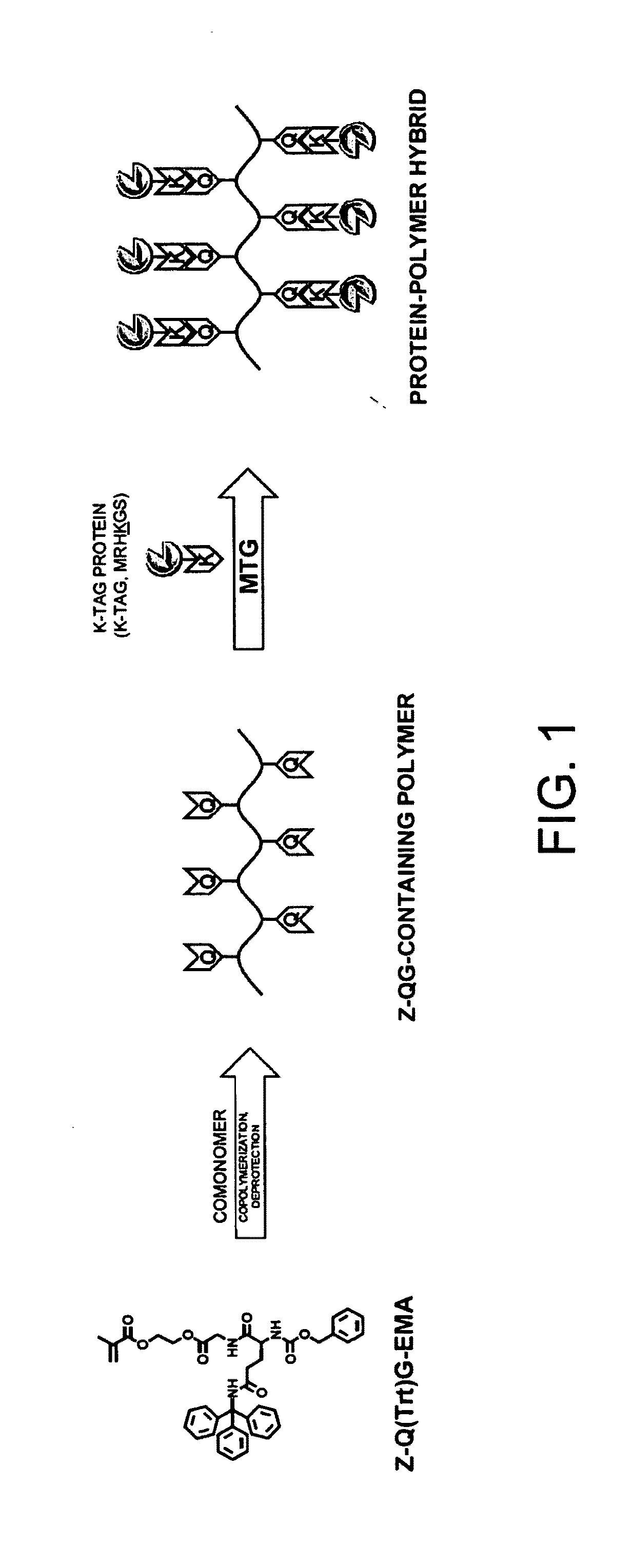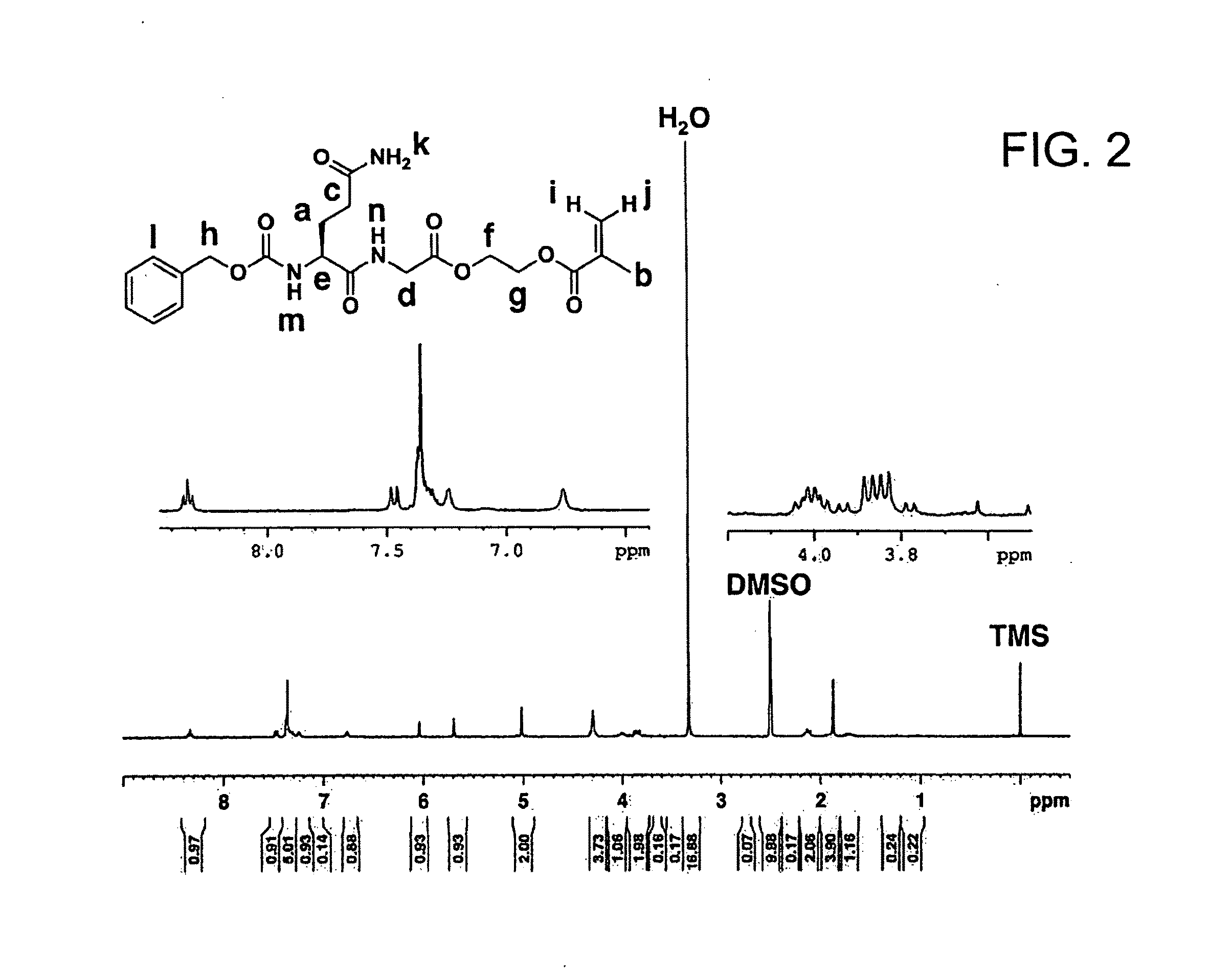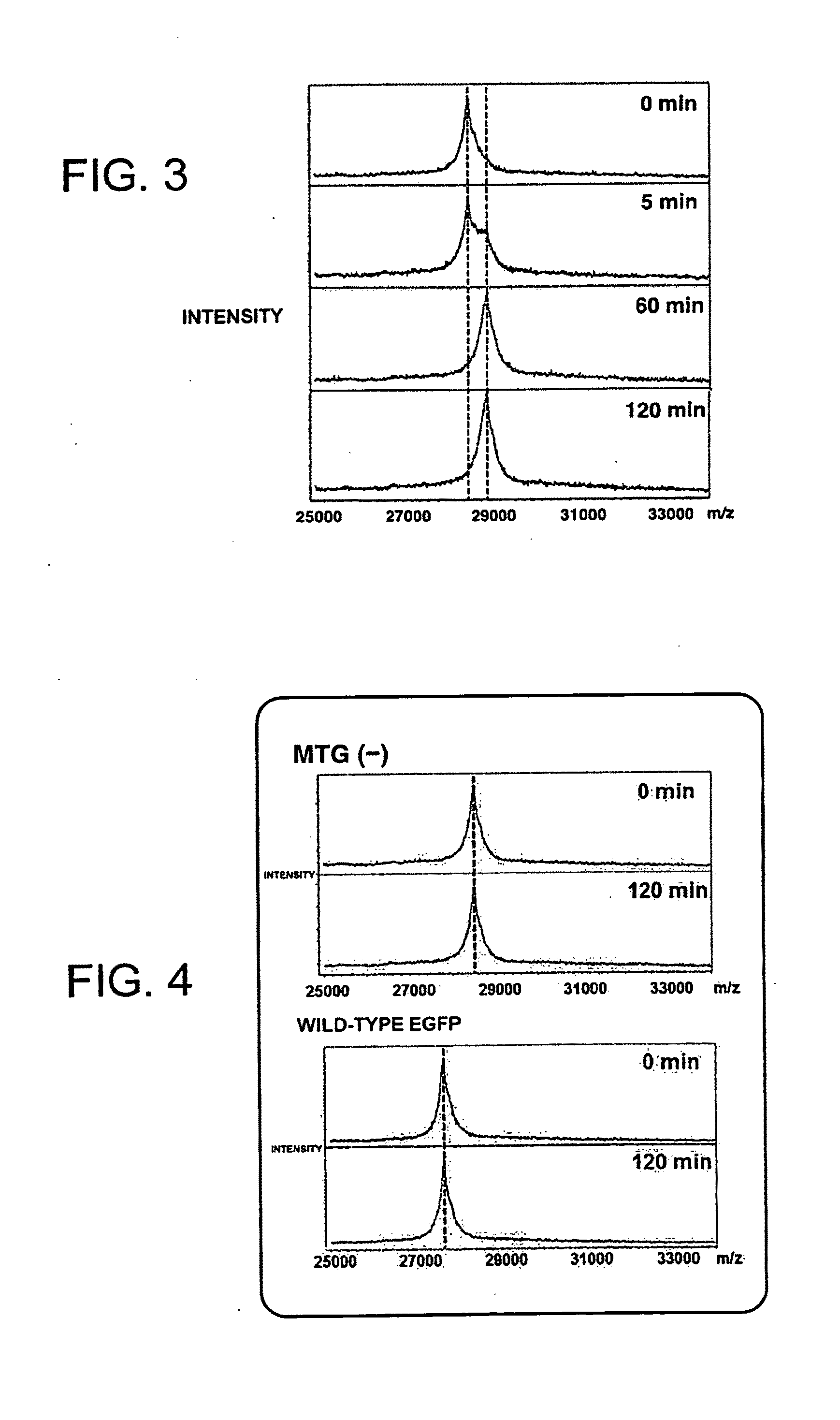PROTEIN-POLYMER COMPLEX, TGase SUBSTRATE-CONTAINING POLYMER, TGase SUBSTRATE-CONTAINING MONOMER, METHOD FOR PRODUCING PROTEIN-POLYMER COMPLEX, AND METHOD FOR IMPROVING PROTEIN FUNCTION AT SOLID-LIQUID INTERFACE OR IN VICINITY OF SOLID-LIQUID INTERFACE
a technology of protein polymer and substrate, which is applied in the direction of instruments, enzyme stabilisation, peptides, etc., can solve the problems of enzyme activity degradation, and achieve the effects of improving protein function, good sensitivity, and enzyme reaction efficiency
- Summary
- Abstract
- Description
- Claims
- Application Information
AI Technical Summary
Benefits of technology
Problems solved by technology
Method used
Image
Examples
example 1
Evaluation of Reactivity of Z-QG-Containing Monomer with MTG
[0117]In order to evaluate the reactivity of a Z-QG-containing monomer as a Gln substrate, an MTG-catalyzed reaction was performed using an enhanced green fluorescent protein (EGFP) containing a K-tag (MRHKGS) that had been introduced using genetic engineering techniques as a model protein. First, the Z-QG-containing monomer Z-QG-EMA was synthesized.
Synthesis of Z-QG-EMA
[0118]
[0119]A 200 mL round-bottom flask was charged with Z-QG-OH (0.20 g, 0.59 mmol), N,N-dimethylformamide (DMF) (6.5 mL) was added, the mixture was cooled in ice, and then HEMA (0.17 g, 1.3 mmol, 2.2 eq. / Z-QG-OH) was added. Subsequently, DCC (0.15 g, 0.71 mmol, 1.2 eq. / Z-QG-OH) and HOBt (0.11 g, 0.73 mmol, 1.2 eq. / Z-QG-OH) were added. DMAP (15 mg, 0.12 mmol, 0.21 eq. / Z-QG-OH) was then added, the temperature was raised gradually to room temperature, and the mixture was then stirred at room temperature for 4 hours. A reaction trace was performed by thin laye...
example 2
Synthesis 2 of Z-QG-EMA
[0181]A 200 mL round-bottom flask was charged with Z-QG-OH (0.51 g, 1.5 mmol), anhydrous N,N-dimethylformamide (anhydrous DMF) (15 mL) and HEMA (0.39 g, 3.0 mmol, 2.0 eq. / Z-QG-OH) were added, and the mixture was cooled in ice. Subsequently, DCC (0.37 g, 1.8 mmol, 1.2 eq. / Z-QG-OH) and HOBt (0.29 g, 1.9 mmol, 1.3 eq. / Z-QG-OH) were added. DMAP (37 mg, 0.30 mmol, 0.21 eq. / Z-QG-OH) was then added, the temperature was raised gradually to room temperature, and the mixture was then stirred at 40° C. for 20 hours. The white solid that formed in the reaction solution was removed by suction filtration, and the solvent was then removed by distillation under reduced pressure. The product was dissolved in dimethyl sulfoxide (DMSO), ethyl acetate was used as the organic layer, and the organic layer was washed with a 10% aqueous solution of citric acid and then a 5% aqueous solution of sodium bicarbonate. The organic layer was then washed in a saturated saline solution, and f...
example 3
[0200]A poly(Z-QG-TEGMA-co-Acrylamide) (Z-QG content 4%), as Z-QG-containing polymer, synthesized by radical copolymerization of Z-QG-TEGMA and Acrylamide, and K-tag EG were complexed using MTG.
Preparation of K-Tag EG and CBM-Deficient K-Tag EG
[0201]For the K-tag EG and CBM-deficient K-tag EG, recombinant proteins prepared in E. coli were used. The amino acid sequences of these proteins are shown in SEQ ID NO: 28 and 29 respectively.
[0202]Using the genomic DNA of the BAA-629D-5 strain of Thermobifida fusca purchased from ATCC (American Type Culture Collection) as a template, and using primers of SEQ ID NO: 30 and 31 respectively, the full length EG gene was amplified by PCR. Moreover, by subjecting the obtained amplified product to repeated PCR using primer pairs of SEQ ID NO: 30 and 32, and SEQ ID NO: 31 and 33, K-tag was introduced at the downstream of the EG gene. The DNA fragment of the thus obtained full length K-tag EG gene was recombined with the pET22b+ vector using an in-Fu...
PUM
 Login to View More
Login to View More Abstract
Description
Claims
Application Information
 Login to View More
Login to View More - R&D Engineer
- R&D Manager
- IP Professional
- Industry Leading Data Capabilities
- Powerful AI technology
- Patent DNA Extraction
Browse by: Latest US Patents, China's latest patents, Technical Efficacy Thesaurus, Application Domain, Technology Topic, Popular Technical Reports.
© 2024 PatSnap. All rights reserved.Legal|Privacy policy|Modern Slavery Act Transparency Statement|Sitemap|About US| Contact US: help@patsnap.com










